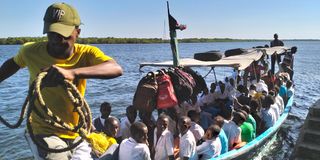The picturesque but deadly route used by learners in Lamu islands

A coxswain prepares to steer a boat full of students of Majembeni and Uziwa secondary schools at the Mokowe Jetty on the mainland from Lamu Island after a day's learning. For the thousands of learners pursuing education to get a chance at a better life, the voyage to school is risky, spectacular and simply beautiful. But it is also full of adventure, surprises and sometimes, danger.
The Lamu Archipelago made up of 35 islands surrounded by the mighty Indian Ocean is a secluded region accessible mostly by water transport.
And for the thousands of learners pursuing education to get a chance at a better life, the voyage to school is risky, spectacular and simply beautiful.
But it is also full of adventure, surprises and sometimes, danger.
Often, the learners report late to school but the teachers understand because, in this part of Kenya, it is a common phenomenon to come across dhows or boats full of secondary students or primary school pupils in uniforms as they traverse the vast Indian Ocean.
Every morning, tens of pupils in these remote islands where there are no learning institutions make their way to beaches to board the water vessels.
For instance, Ras Kitau Island which has over 200 households residing has no school.
Students and pupils here normally cross over to either Shela or Lamu Old Town to attend school.
The first phase of the ocean voyage takes them through the shallow ocean and slowly transitions into the deep sea where there is no nearby shore to swim should the wooden canoes capsize.
The coxswain sits at the back of the tree dugout canoes where they steer and balance the canoe while keeping an eye on its occupants who sometimes do not have life jackets.
Many times during high waves, water swamps the vessels and the learners are forced to bail it out.
The journey from Ras Kitau to Shela or Lamu Old Town involves navigating through the Mlango wa Shela, a renowned dangerous and killer channel in the archipelago.
The ocean at Shela is at its deepest point, a situation that always characterises the channel with rough currents accompanied by strong waves.
Here, boats and dhows are always prone to capsise and every time they undertake this trip, the children are exposed to life-threatening dangers.
Kombo Nyanje, 56, an elder who has lived in Ras Kitau for 19 years told Nation.Africa that the cost of transport has been a headache for parents as they need at least Sh200 daily to cater for their children’s boat fare to and from the neighbouring Shela island.
Mr Nyanje notes that during high tides when the ocean experiences strong winds and tidal waves, school-going children in Ras Kitau are forced to cancel their travels for safety reasons.
“The government needs to do something in Ras Kitau. In this century, we have no school or dispensary. Our children have to cross over to either Shela Primary or go all the way to Lamu Old Town to attend school. We need educational institutions and dispensaries within our vicinity as the population here continues to grow daily,” pleaded Mr Nyanje.
The situation is similar in Manda Island where learners either cross over to Lamu Old Town within Lamu Island or vice versa to attend classes daily.
At Manda Airport Secondary, for instance, 130 students from Form 1 to Form 4 who live in Lamu Old Town are ferried by boat from Lamu to Manda daily.
Principal James Kimemia told Nation.Africa on Tuesday that the situation exposes his students to risks, especially during times when the Indian Ocean becomes windy or rough.
Every student pays Sh20 one way for the journey which takes between 10 to 20 minutes.
Mr Kimemia said the difficult transport situation interrupts learning as teachers are forced to cut short their lessons to allow students to cross over to Lamu Island before the ocean gets rougher in the evening.
The school principal pleaded with the Ministry of Education and the county leadership to consider buying special dhows and boats for schools to enable the students to have defined and proper means of transport.
“Every day, our students are supposed to be at the Lamu Jetty by 6am to catch up with public boats or dhows coming to Manda Island. Sometimes these vessels are not enough. That means they have to wait for other boats, hence coming to school late. These students are then required to be out of class by 3pm to catch the boats to cross over to Lamu Island. That means sometimes they don’t attend all the afternoon lessons. This inconvenience can only be sorted if we get our own boat or dhow as a school,” said Mr Kimemia.
Athman Musa, a boat captain plying the Lamu Island to Manda Island route says he gets not less than Sh4,000 from ferrying students and pupils to and from school daily.
“My dhow has a small engine of 15HP (horsepower) which is preferred by many school children. From Lamu to Manda Island, I charge Sh2,000 when my boat is full. That means the two-way journey, I bank Sh4,000 daily. Business is good,” said Mr Musa.
Ali Omar owns a bigger vessel plying the Lamu Old Town to Mokowe Jetty.
The boat has a capacity of between 90 and 100 passengers.
Mr Omar says ferrying students to full capacity, he always earns between Sh8,000 to Sh9,000 in a single trip.
It is, therefore, clear that the cost of education and the risk to safety and personal welfare is high across the Lamu Archipelago.
Being a student, pupil or parent in the Lamu Islands is tough and only needs nothing but sacrifice and commitment in equal measure.





